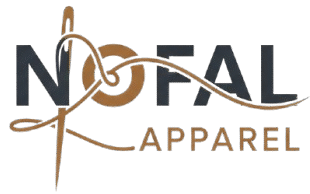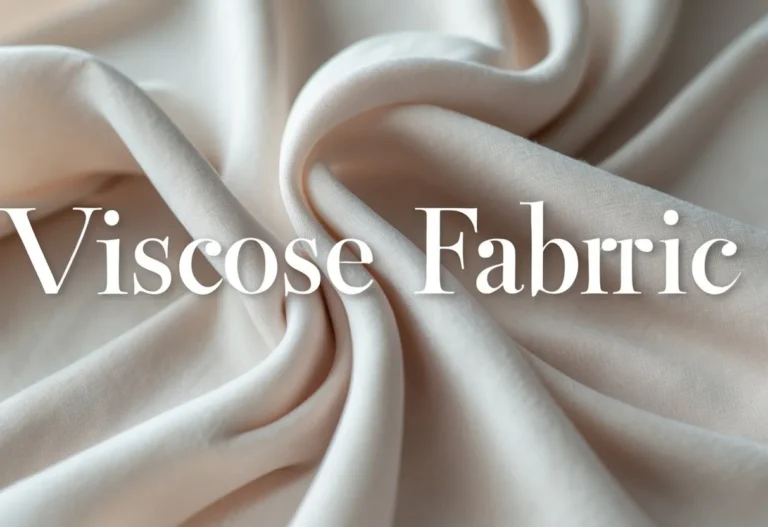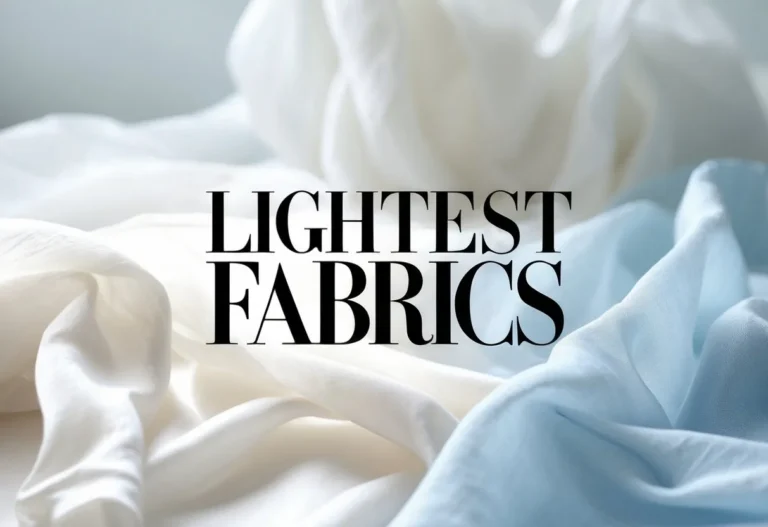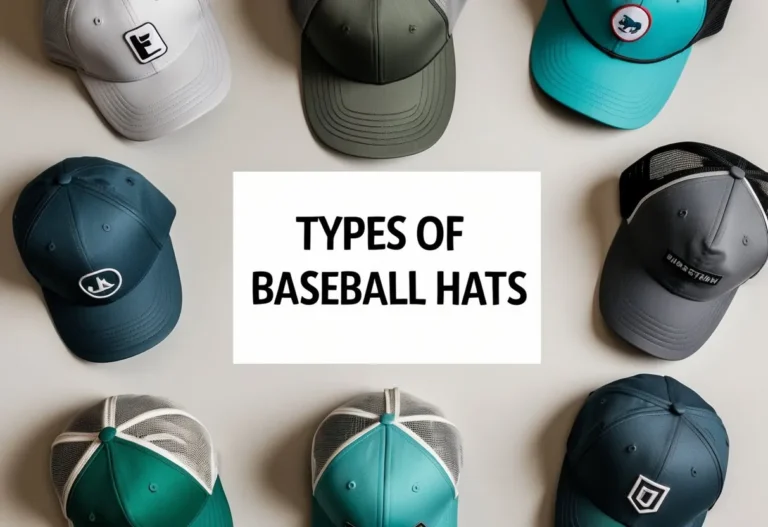Knitted fabrics are versatile materials made by looping yarns together, which gives them flexibility and stretch. This unique structure makes them different from woven fabrics, allowing for comfortable and form-fitting clothing. Knitted fabrics come in various types, each suited for different uses based on their texture, weight, and stretchability.

These fabrics are widely used in casual wear, sportswear, and luxury fashion due to their softness and durability. Advances in knitting technology have introduced seamless designs and sustainable fibers, expanding their applications even further. Understanding the types of knitted fabrics helps in choosing the right one for any project or garment.
People who work with or wear knitted fabrics benefit from knowing how these materials perform, how to care for them, and where they are most effectively used. This knowledge supports making better decisions in manufacturing, design, and everyday clothing choices.
Key Takeaways
- Knitted fabrics are defined by their stretch and flexible looped yarn structure.
- Different knit types serve varied purposes, from casual clothes to high-performance wear.
- Modern technology and fiber choices have improved function and sustainability in knitwear.
Understanding Knitted Fabrics
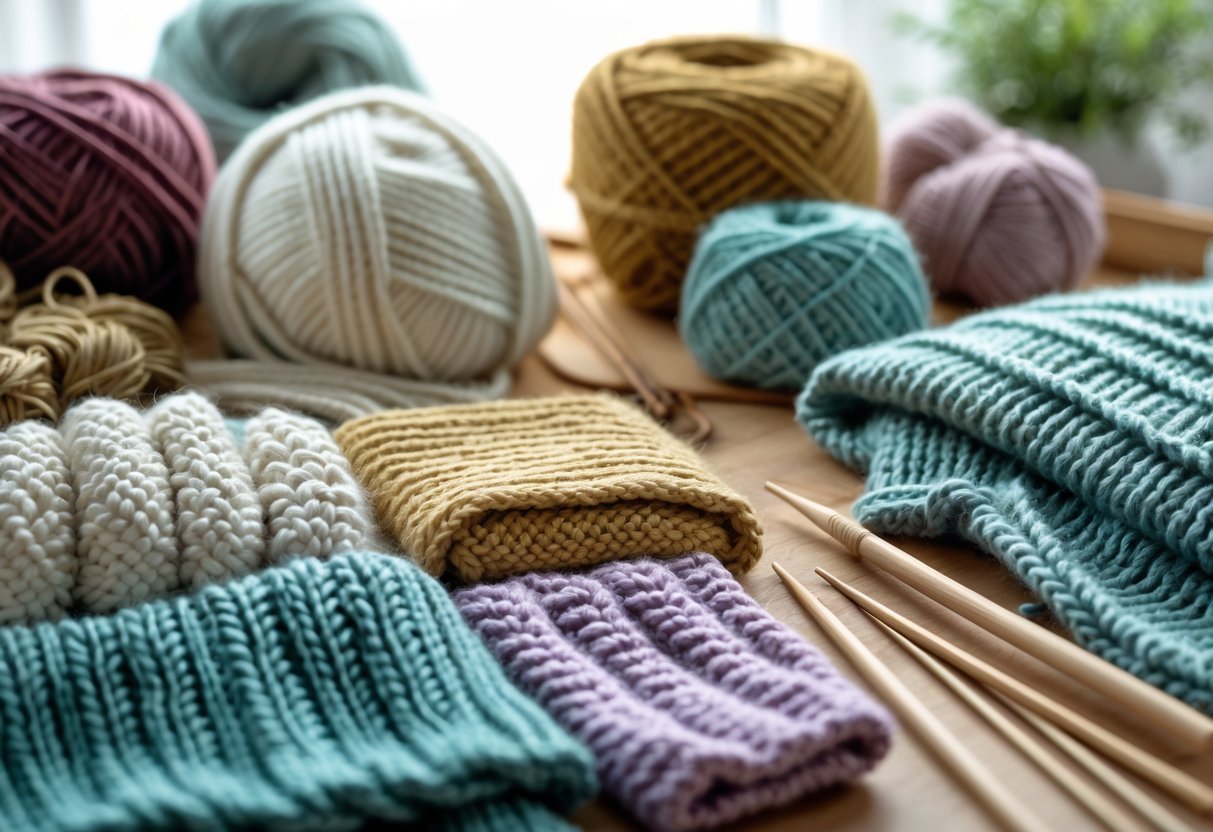
Knitted fabrics create textile materials with loops of yarn that give them stretch and flexibility. These fabrics differ from others by the way they are made and their unique properties that suit many uses. Knowing how knitted fabrics work helps in selecting the right type for different needs.
What Are Knitted Fabrics?
Knitted fabrics are made by interlocking loops of yarn in a series, creating a stretchy fabric. Unlike woven fabrics, where threads cross at right angles, knitting uses continuous yarns that loop together. This loop structure allows the fabric to expand and move easily.
There are two main knitting methods: weft knitting, which runs loops across the fabric’s width, and warp knitting, where loops run vertically. This variety means knit fabrics can range from thin and soft to thick and insulating. Common knit fabrics include jersey, rib, and interlock types, used in clothing like t-shirts, sweaters, and activewear.
Key Properties of Knitted Textiles
Knitted fabrics offer high elasticity, comfort, and good wrinkle resistance. The loops give the fabric the ability to stretch in different directions, making it ideal for fitted garments and activewear. It also allows for better air flow compared to woven fabrics.
Other important features include lightweight feel and quick production. Knit fabrics can be more durable when made with the right yarn and knitting method. Some knits absorb moisture well, making them good for underwear and sportswear. The flexibility in yarn choice and knitting style lets manufacturers tailor the fabric for different uses.
Knitting vs. Weaving
Knitting differs from weaving mainly in how threads are arranged. Weaving uses two sets of yarns that cross each other at right angles, making the fabric less stretchy and more rigid. In contrast, knitting loops the yarn in continuous rows, creating a flexible textile.
Woven fabrics usually have better shape retention and strength, which is why they suit items like pants or jackets. Knit fabrics excel in stretch and comfort, making them preferred for t-shirts, sweaters, and activewear. Additionally, knitting can often be faster and less costly to produce than weaving, especially for stretchy or complex designs.
Types of Knitted Fabrics

Knitted fabrics vary by stitch pattern and construction, each offering different stretch, texture, and durability. The differences come from how yarns loop through knitting machines or by hand using knitting needles. Three common types are single jersey, rib knit, and interlock knit, each suited for specific uses in clothing and textiles.
Single Jersey
Single jersey is a lightweight knit fabric made with a single set of knitting needles. It has a smooth front side and a slightly textured back. This fabric naturally curls at the edges when cut.
It is soft, breathable, and stretches mostly widthwise but has less recovery compared to rib knits. Single jersey is common for T-shirts, dresses, and casual wear where comfort and flexibility are important. It’s produced quickly on flat or circular knitting machines, making it cost-effective.
Despite its stretch, single jersey is less stable, so it may lose shape over time without proper finishing.
Rib Knit
Rib knit fabric consists of alternating knit and purl stitches, forming raised vertical lines called ribs. This structure uses two or more sets of needles, increasing the fabric’s elasticity and recovery.
Ribbing provides strong stretch in both width and length. It holds its shape well, making it ideal for cuffs, waistbands, collars, and body-hugging garments. Rib knit offers more thickness and durability than single jersey.
It’s also valued for its textured look and ability to conform closely to the body. Knitting machines can adjust needle size and arrangement to create different rib widths and stretch levels.
Interlock Knit
Interlock knit is a double-knit fabric created by knitting two layers simultaneously using two sets of needles. This produces a smooth, dense fabric with identical front and back sides.
It combines the stretch of knit fabrics with extra strength and less curl than single jersey. Interlock is thicker and heavier, offering better insulation and durability.
This fabric is common for polo shirts, activewear, and professional clothing where a polished finish is needed with some stretch. It resists wrinkling and maintains shape well after washing.
Its tight knit structure allows it to hold prints and colors effectively.
Stretch and Specialized Knitted Fabrics

Knitted fabrics vary widely in stretch and texture, adapting to different uses. Some stretch fabrics include spandex blends for extra flexibility. Others, like sweater knits, focus on warmth and thickness. Decorative knits such as lace add visual interest and delicacy to garments.
Stretch Knits and Spandex Blends
Stretch knits are made by blending fibers like spandex with traditional yarns. Spandex gives fabrics excellent elasticity, allowing them to stretch and return to their original shape. This makes these knits ideal for activewear, leggings, and fitted clothing.
The combination offers both comfort and support. Stretch knits often feature smooth textures and are lightweight. Their elasticity improves freedom of movement without losing shape after wear.
These fabrics are also durable, resisting sagging even after repeated stretching. When selecting stretch knits, it’s important to note the percentage of spandex; higher amounts mean more stretch but less breathability.
Sweater Knits
Sweater knits are thick, often made with heavier yarns to provide warmth and softness. They are commonly used for sweaters, cardigans, and cold-weather apparel. These fabrics offer insulation while remaining flexible to allow comfortable wear.
The texture can vary from smooth to chunky, depending on the knitting technique. Sweater knits often show visible stitch patterns, which add style and depth to the fabric.
This knit type is less stretchy than weft knits with spandex but designed for durability and warmth. It resists pilling and retains shape well, making it suitable for winter garments.
Lace and Decorative Knits
Lace and decorative knits emphasize pattern and appearance over stretch. They are created with open, intricate designs, adding elegance and breathability to clothing.
Lace knits often use fine threads for a delicate feel. Despite their lightweight nature, they maintain good durability through specialized stitching techniques.
These knits are popular in dresses, blouses, and lingerie. They allow for airflow and offer a decorative element that simple knits lack, making them a preferred choice for formal wear and layered outfits.
Materials Used in Knitted Fabrics
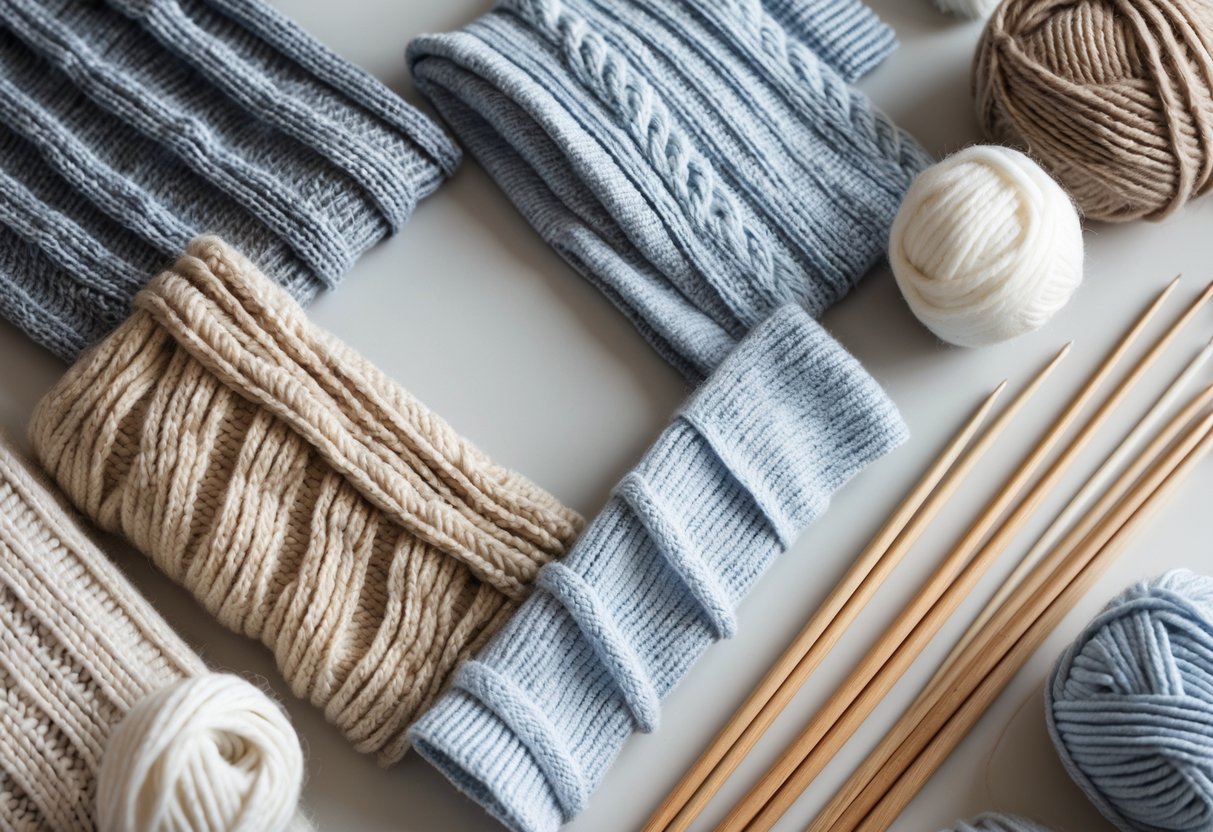
Knitted fabrics use a variety of fibers, each with unique qualities that affect their feel, durability, and purpose. Natural fibers tend to offer breathability and comfort, while synthetic options bring strength and stretch. Specialty materials add texture and distinct appeal for specific uses.
Natural Fibers: Cotton, Wool, Silk, Cashmere
Cotton is a soft, breathable natural fabric often used for everyday wear like t-shirts and casual clothing. It absorbs moisture well and is comfortable against the skin.
Wool provides excellent warmth and insulation. Wool fabric is common in sweaters and winter garments because it retains heat but also allows air circulation. Cashmere, a type of wool, is finer and softer. It is used for luxury knitwear due to its lightweight warmth.
Silk adds smoothness and a natural sheen. Silk knits drape well and offer a luxurious feel, often used in high-end fashion items like blouses and dresses. Mixed with other fibers, silk balances softness and durability.
Synthetic Fibers: Polyester, Nylon, Blends
Polyester is a strong synthetic fabric known for its wrinkle resistance and quick drying. It is widely used in activewear because it handles moisture and stretch well. Polyester blends often include spandex to improve elasticity and fit for sportswear and leggings.
Nylon is another synthetic fabric prized for strength and durability. It resists wear and tears, making it useful in performance and outdoor clothing. When knitted, nylon also offers good stretch and recovery.
Blended fabrics combine natural and synthetic fibers to balance comfort with functionality. These knits benefit from the softness of natural fibers and the resilience of synthetics.
Specialty Materials: Velvet, Leather
Velvet is a knit fabric with a dense pile, creating a soft, plush surface. It’s often used in upholstery or formal clothing for its rich texture and visual depth.
Leather knit is less common but used for unique fashion pieces. It combines the strength and smooth finish of leather with the flexibility of knit, offering durability and style in garments like jackets or accessories.
Both velvet and leather add tactile interest and elevate the appearance of knitted products beyond traditional fabrics.
Uses of Different Knitted Fabric Types

Knitted fabrics serve many purposes due to their flexibility and structure. Their uses vary based on the type of knit, the stretchiness, and the fabric’s feel. These factors help decide which knit fabric suits specific products in fashion and home textiles.
Apparel: Sweaters, Dresses, Underwear
Knitted fabrics are widely used in apparel because of their softness and stretch. Sweaters often use thicker knits to provide warmth and comfort. Wool or acrylic weft knits are common for their elasticity and insulation.
Dresses made from finer knits offer good drape and stretch, allowing freedom of movement. Jersey knit fabrics are popular here because they balance comfort with shape retention.
Underwear frequently uses lightweight, breathable knits. Cotton or synthetic blends with good stretch support fit and breathability. Warp knits add strength and durability, often found in lingerie and shape-wear, where stretch and recovery are crucial.
Activewear and Stretch Applications
In activewear, stretch is essential for comfort and performance. Knit fabrics with high elasticity, like spandex blends, allow flexibility for activities like running or yoga.
Warp knits are common in this category because they resist runs and provide firm support. These fabrics also dry quickly and are breathable, important for athletic use.
Stretch fabric in this segment helps reduce friction and adapts to body movement. It is often used in leggings, sports bras, and compression wear to improve fit and function.
Home Textiles and Accessories
Knitted fabrics appear in home textiles and accessories, often for their softness and texture. Items like blankets, cushion covers, and throws use thick weft knits for warmth and visual appeal.
Accessories such as hats, scarves, and gloves depend on knit fabrics for stretch and comfort. The elasticity of knit allows for easy wear and a snug fit.
Knits also offer durability and breathability, making them a practical choice for decorative and functional home items.
Knitted Fabrics in the Textile Industry
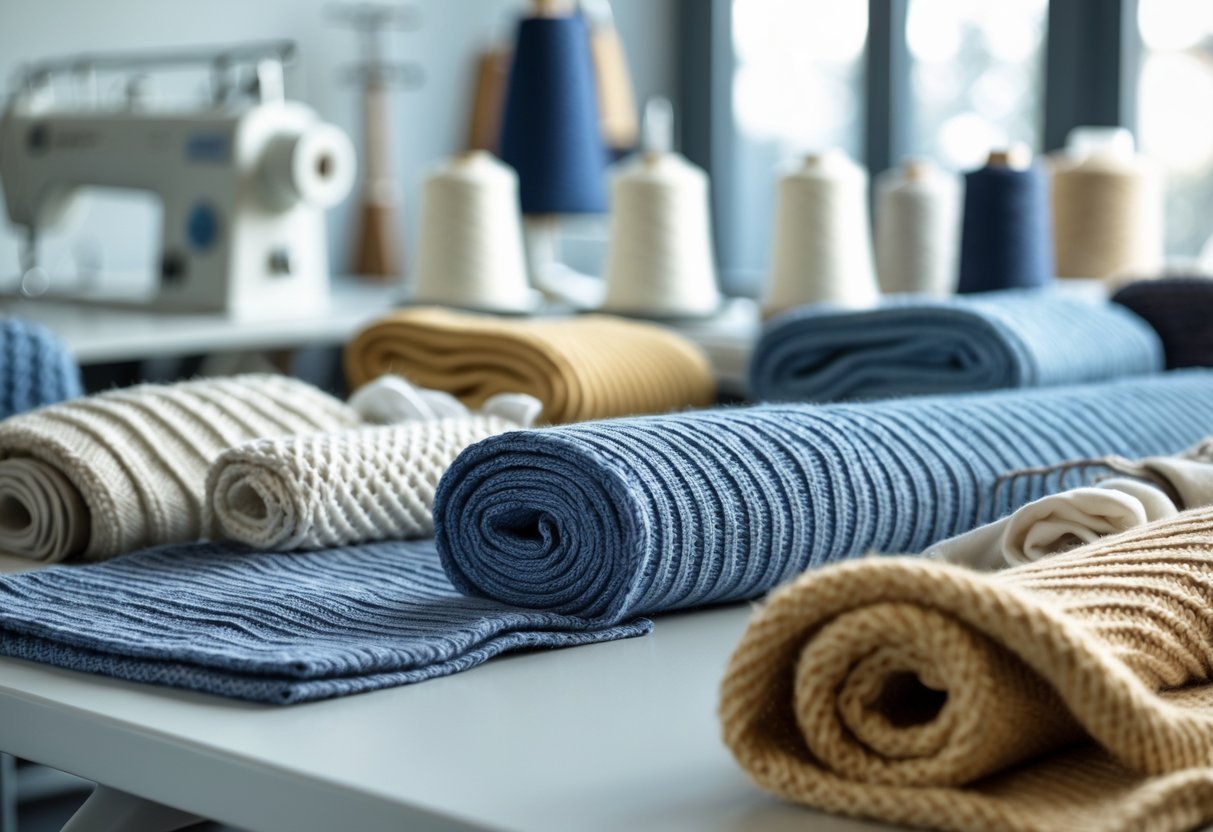
Knitted fabrics have become a vital part of the textile industry due to their unique features like stretch, softness, and versatility. Their ability to adapt to different needs makes them valuable in countless products and manufacturing processes. Understanding their role helps clarify why they are favored over other types of fabric in certain areas.
Role in Modern Fashion
Knitted fabrics are widely used in modern fashion because they offer comfort, flexibility, and style. Types such as jersey, rib, and interlock knits are popular for clothing that fits closely to the body. These fabrics stretch easily, making them ideal for casual wear, activewear, and even formal clothing.
The fashion industry values knits for their ability to hold shape while allowing movement. Areas like cuffs, collars, and waistbands often use rib knit due to its strong stretch and recovery. Lightweight jersey knits are favored for T-shirts and dresses as they provide softness and breathability.
Knits also support diverse textures—from smooth to textured surfaces like pique—giving designers flexibility in creating different looks. The adaptability of knitted fabrics helps brands meet consumer demands for comfort combined with style.
Sustainable Knitting Practices
Sustainability in textile manufacturing has become a focus, and knitted fabrics play a key part in this shift. Manufacturers are increasingly using eco-friendly yarns made from organic cotton, recycled fibers, or biodegradable materials. These choices reduce the environmental impact of fabric production.
Knitting machines are more energy-efficient than some weaving methods, which helps lower carbon footprints. Waste is also minimized because knit fabrics can be made to exact measurements without excess cutting.
Some manufacturers implement closed-loop systems to recycle fabric scraps and water, further promoting sustainability. The combination of material innovation and efficient production processes makes knitted fabrics a practical choice for brands aiming to reduce environmental harm.
Frequently Asked Questions
Knitted fabrics come in various types, each with unique features suited for different uses. The knitting method strongly influences fabric stretch, feel, and strength. Choosing the right knit depends on the intended function, including sports or fashion needs. Durability and environmental effects are also key concerns when selecting and producing knitted fabrics.
What are the different types of knitted fabrics and their characteristics?
Common types include jersey, rib, interlock, and fleece. Jersey is lightweight and smooth with good stretch. Rib has vertical lines and more elasticity. Interlock is thicker and more stable, with a smooth double-knit surface. Fleece is soft and warm, used mostly for cold-weather clothing.
How do the knitting techniques affect the properties of a fabric?
Knitting flat produces fabric in sheets, while circular knitting creates seamless tubes. The stitch type, such as loop size and pattern, impacts elasticity, thickness, and texture. Double-loop stitches add softness and bulk, useful in fabrics like terry or velour.
Which knitted fabrics are best suited for athletic wear and why?
Fabrics with stretch and moisture-wicking ability are preferred for sportswear. Jersey and rib knits offer flexibility and comfort. Synthetic blends improve breathability and durability. Lightweight knits allow ease of movement without trapping heat.
What factors should be considered when choosing knitted fabrics for fashion design?
Designers should consider stretch, weight, drape, and texture. Color and pattern options also matter. The fabric’s ability to hold shape and stretch without distortion is key for fit. Care requirements and fabric longevity balance style with practical use.
How can the durability of knitted fabrics be assessed and improved?
Durability depends on yarn quality, stitch type, and fabric weight. Testing includes stretch recovery and resistance to pilling. Using tighter knits and stronger fibers can increase lifespan. Proper finishing like washing and heat treatment also enhances durability.
What are the environmental impacts of producing knitted fabrics?
Production involves energy use, water consumption, and chemical inputs. Synthetic fibers contribute to microplastic pollution. Sustainable choices include using recycled yarns and natural fibers. Advances like 3D knitting reduce waste by creating precise, seamless products.
